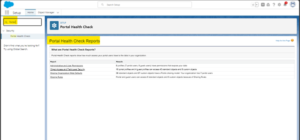Aloha trailblazers!
With the rise of digitalization, the demand for advanced solutions has surged, leading to the inception of the Secure Experience Cloud. This powerful Salesforce feature allows external or unauthenticated users to access a subset of your data securely. While advantageous, this functionality carries the risk of potential security threats, which can be mitigated by implementing robust security measures.
Data breaches pose significant risks, with an average cost of around $10M, according to recent studies. To safeguard your organization, follow the secure steps outlined below.
Setting up your Org Wide Defaults
Org-wide defaults is a very well-known and effective technique in terms of the security aspect of the Salesforce Ecosystem. In general, OWD should be set to the most restrictive setting to protect against any kind of unauthorized access to your sensitive data.
Widening the Security Horizon via Roles
You can assign roles to your guest users thus enabling the sharing of only data that is safe to share with them. Along with the roles you can combine the sharing rules. Each Experience Cloud site has a dedicated guest user for sharing rules, maximizing its power.
Assigning the Right License
Access to objects is determined based on the license type, such as High-Volume Customer Community, Customer Community Plus, and Partner Community. Therefore, profiles can be employed to regulate access to objects, fields, and other elements. Adhere to the principle of least privilege by initially restricting access. Then selectively grant access to necessary fields and record types. Avoid relying on assumptions of trust in security protocols.
Enable Clickjack Protection in Experience Cloud Sites
Clickjacking is basically a type of attack where users are tricked into clicking some buttons or links that may appear as safe. Hackers can trick users by creating hidden iframes pointing to Site pages. This makes users click elements that seem to be from another page. But instead of the visible button handling the click, it is hijacked by the element of the invisible iframe. Clickjacking can lead to data intrusion, unauthorized emails, updated credentials, and many other malicious activities. With clickjacking protection, you can secure your site by controlling whether browsers allow frames to point to your pages.
Encrypting the Cloud Site Data
You can safeguard your data by adding encryption. You can encrypt your files, fields, and attachments.
Use Nicknames instead of Full Names
Displaying the nicknames instead of full names adds to the privacy and protects the member’s identity. This is extremely beneficial in the case of a public site where unregistered visitors can access the member profiles.
Regularly Run Security Scans
Tools like Salesforce event monitoring, IBM Qradar, and CheckMarx can conduct regular health scans. These scans identify potential vulnerabilities in your Experience Cloud site. Monitoring unauthenticated user behavior can be complex. However, tools like Google Analytics help understand user patterns and behavior effectively.
You should run Portal Health Checkup frequently and consider taking appropriate actions as per Salesforce Recommendations.
You can access the Portal Health Check, by searching it from the quick find box
Enable Multi-Factor Authentication
Multi-factor authentication (MFA) is a crucial component in fortifying the security of Salesforce Experience Cloud, as it adds an extra layer of protection to the login process. MFA mandates users to present two or more authentication factors, such as a password and a security token, to gain access to the system.
It is imperative to ensure that every user within the Salesforce organization, whether internal or external, employs MFA, even if they utilize single sign-on (SSO). While SSO offers a convenient way for users to access multiple systems with a single login, it does not offer the same level of security as MFA.
In conclusion, securing your Experience Cloud is essential to protect against potential breaches and safeguard sensitive data. By implementing steps such as setting up stringent Org Wide Defaults, leveraging roles and licenses effectively, enabling Clickjack Protection, and regularly running security scans, you can enhance your system’s defense against unauthorized access and malicious activities. Additionally, enabling Multi-Factor Authentication (MFA) adds an extra layer of security to the login process, ensuring the integrity and confidentiality of your data. Prioritizing these security measures is crucial for maintaining trust, resilience, and success in today’s digital landscape.
You can also explore more about security fundamentals by going through our below blogs.
Securing Your Salesforce Ecosystem: A Comprehensive Guide to Using Checkmarx





